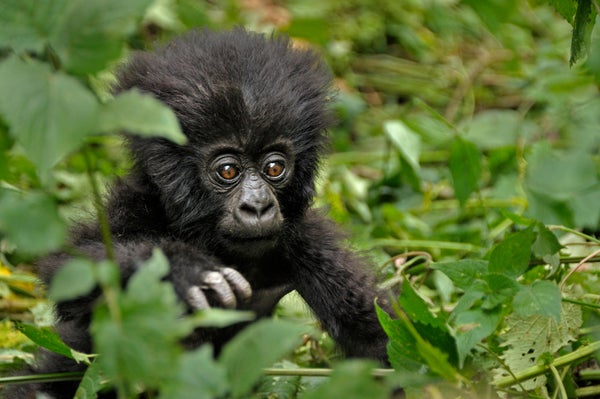Whether you’re a human or an elephant, a baboon or a fish, adversity experienced early in life is often linked to negative effects on longevity and health in adulthood. But this tendency, seen across the animal kingdom, seems to have at least one exception: mountain gorillas. So long as young gorillas who experience adversity make it past the age of six, they will go on to lead lives just as long as their untraumatized peers, researchers reported on May 15 in Current Biology.
“For reasons we’re still trying to understand, gorillas seem to be remarkably resilient to early-life adversity,” says Stacy Rosenbaum, a biological anthropologist at the University of Michigan and senior author of the new paper. Understanding how one of our closest relatives copes with early life trauma could strengthen insights into why some people manage to do the same, she adds, whereas others continue to be haunted by negative childhood experiences throughout life.
Studying how long-lived animals in the wild respond to early-life adversity is difficult, and until now, researchers did not have much insight into the impact such events have on nonhuman great apes. Evidence suggests that chimpanzees and bonobos who suffer early-life traumas in captivity oftentimes go on to develop long-term psychological problems. But it’s difficult to disentangle those observations from the fact that these animals are kept in unnatural settings.
On supporting science journalism
If you're enjoying this article, consider supporting our award-winning journalism by subscribing. By purchasing a subscription you are helping to ensure the future of impactful stories about the discoveries and ideas shaping our world today.
The new study was made possible by the existence of a unique database currently managed by the Dian Fossey Gorilla Fund, a nonprofit conservation group in Rwanda. Launched in 1967, the database contains daily, lifelong observations of more than 400 mountain gorillas monitored in Rwanda’s Volcanoes National Park. “It’s really, really unusual to have that kind of detailed demographic data to do a study like this, especially in wild apes,” Rosenbaum says. “Literally hundreds of people over 55 years went out every day to watch the gorillas.”
Rosenbaum and her colleagues focused on 253 gorillas from 19 social groups. They examined whether each animal experienced any of six types of early-life adversity before age six, including losing their mom or dad, living through group instability or witnessing the infanticide of a fellow young animal. Then the team looked at how long each of the animals in the study lived.
Young gorillas who were exposed to multiple adversities suffered up to nearly 30 times the risk of death before age six, the researchers found. But to their surprise, those individuals that did manage to survive past age six experienced no negative impact on how long they lived. In fact, males who experienced the highest levels of adversity tended to live longer than males who experienced the least amount of adversity—a finding that Rosenbaum and her colleagues think is likely attributable to viability selection. “The basic idea is that you only survive that early stuff if you’re a particularly high-quality animal,” she says.
For female gorillas, there was no difference in longevity, whether or not the animals went through a tough first few years. Taken together with the finding about male gorillas, this suggests that the species in general is “just more resilient,” Rosenbaum says.
“It is quite surprising to learn that individuals who weather adversity in their early years do not suffer long-term consequences for survival,” says Melissa Emery Thompson, an evolutionary anthropologist at the University of New Mexico, who was not involved in the new study. “Obviously, humans are not gorillas, but it is incredibly valuable to have comparative data on this phenomenon in a long-lived species and one that shares so many biological similarities with humans.”
Rosenbaum and her colleagues do not have a definitive explanation for their findings, but they do have a hypothesis. For one, the gorillas whose lives are recorded in the database “live in this weird little bubble” where they do not face ecological scarcity, Rosenbaum says. There’s plenty of water and food, and the forest is protected from loggers and poachers, so their physical needs are met. The animals also live in tightly knit social groups with high degrees of support. If a juvenile gorilla is orphaned, for example, other group members, particularly the alpha male, will step in to provide more care.
If this two-pronged explanation proves accurate, then it means that for social animals, evading the deleterious impacts of early trauma requires both social support and resources, Rosenbaum says. “Gorillas have both,” she adds.
Many questions remain, including whether early-life adversity causes any impacts to gorillas’ health and also what biological mechanisms underpin resilience in the great apes. Using the same database, Rosenbaum and her colleagues have already started working on a follow-up study to investigate health differences between traumatized and untraumatized gorillas as measured through things such as hormone levels obtained through fecal samples, records of illness and injury and relationship dynamics.
Despite the significant differences between humans and our closest great ape relatives, Rosenbaum emphasizes that “we do have a tremendous amount of things in common.” She suspects that the essence of the gorilla findings probably applies to people and other long-lived mammals, too. “When we’re thinking about how to help kids recover from early adversity, it’s very important to keep in mind that it’s not enough to just provide them with social support or to just provide them with economic support,” she says. “If we ignore one or the other, I think the chances of success when doing interventions is not very high.”
